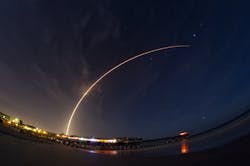NASA seeks industry insight for ascent imagery technology
KENNEDY SPACE CENTER, Fla. - The National Aeronautics and Space Administration (NASA) is asking for industry experts as it explores modernizing ascent imagery systems with the goal of capture optical imagery of launches, provide high-resolution imagery of local flight test events and offer situational awareness to launch personnel. Ultimately, NASA wants to obtain this capability from commercial entities that are able to provide a viable service.
NASA says they are looking for a remotely operatable system that will enable the use of optical tracking systems. The interoperable subsystems to be located or installed may be configured with or without shore power but should be declared to assess ground services availability. NASA seeks a system that supports multi-spectral imaging that produces high-speed visual, infrared, and multi-focal length imagery. The optical tracking systems will generate test data on several targets simultaneously from multiple locations and needs to provide consistently smooth, properly framed images throughout the ascent profile for each deployed location.
NASA notes that it seeks the ability to enable short range, medium ranged, and long range tracked imagery. For short range imagery, NASA say it wants to acquire and deliver launch imagery from a distance of approximately 1200 feet from the launch vehicle. Imagery acquisition equipment is usually located inside the Pad B perimeter fence and typically acquires first motion to loss of view. The imagery acquisition timeframe for short range tracked imagery is typically from T-10 seconds through loss of sight. Due to the proximity to Pad B, any imagery acquisition equipment must be remotely operated.
Medium range tracked imagery will acquire and deliver launch imagery from a site that is located approximately five miles from the launch pad. The imagery acquisition timeframe for medium range tracked imagery is typically from T-0 through loss of sight. The medium range sites may or may not be in the blast danger or flight caution areas which will potentially limit personnel access.
Long range tracked imagery will acquire and deliver launch imagery from a site that is located between five and 40 miles away from the launch pad and must include imagery of SRB separation.
For more information, please visit https://sam.gov/opp/15c374fccae948139a7cb945f565ff0a/view
Questions or submissions can be addressed to Kodi Coles at [email protected] or 321-867-0299 by 8:00 a.m.by 28 April 2023.
